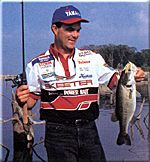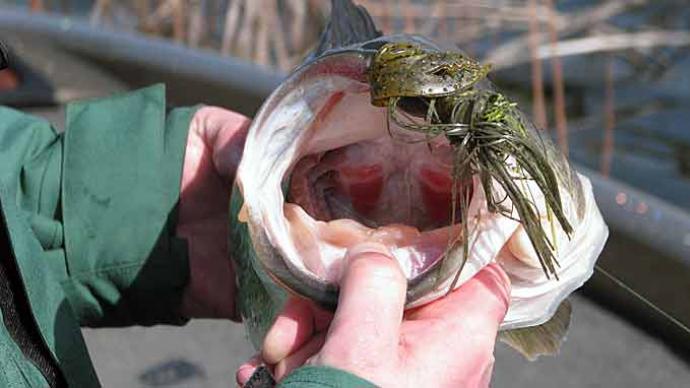
This winter and early spring season of the year is a fine time to chase Mr. Largemouth. Actually, "chase" may not be the right word in these cold water temperatures. A slow, steadfast pursuit is more like it.
Most of the time in late winter, cabin fever is running pretty high. Anglers are ready to rock and roll, but the half-frozen bass are sulking on the bottom somewhere in deep water waiting for spring. These two contradictory and opposing moods often result in a tough bite. Quite often it's a really tough bite.
Typically, fishing during the late winter period is characterized by a few quality fish being caught, but not quantities of fish. By late winter, I am talking about mid-January and February in most of the West, and into March in the Northwest and higher elevations.
The cold water has the bass' metabolism slowed way down, and a fish only has to eat once every 14 days or so when the water is 50 degrees. The bass are just simply inactive most of the time in the cold water of winter, hence, our difficulty in catching them. To catch these fish, my experience in western lakes tells me that an angler needs to slow way down, and drag jigs and plastics slowly on the bottom.
As far as jigs go, I like a 3/4-ounce football head spider jig (Berkley 4" Skirtgrub) in deep, open water, and a 3/8-ounce jig-n-pig around brush or rock.
The reason for the heavy football head is that this is a jig you drag on the bottom in deep water. It works great down 30 to 60 feet. Fish it around the steepest ledges and drop-offs you can find. Bass like vertical breaks in the winter. They will usually bite the jig at the top of the ledge, but sometimes they will be at the bottom of a vertical break, assuming of course that there is a bottom to your ledge.
I use my Lowrance to locate a deep flat that is 30 to 40 feet deep with a vertical break into the old river channel which is usually 100 feet or deeper. I then drag that Berkley Skirtgrub right along the top of that break. Colors I prefer are smoke/black glitter in super clear water (10 feet visibility or more) and pumpkinseed in clear water (5 feet visibility). I use 12-pound Vanish line on my TD-X reel, and the Team Daiwa 6-foot 6-inch heavy jig rod.
The jig-n-pig I use is the 3/8 ounce Berkley Jay Yelas Power Jig with a Power Frog trailer. Pork trailers work as well. This weedless jig is used around much shallower cover like brush and rock. On many of the Colorado River lakes, a good number of the bass stay shallow all winter. Look for steeper banks in coves with brush and/or big rock cover. In this situation you want a lighter jig so it will fall slowly as you pull it over limbs, rocks, etc.. I don't simply drag this jig on the bottom like the spider jig. I work it in and through the best cover around.
For colors on the jig-n-pig, I go with a brown skirt most of the time, a brown trailer in super clear water, and a purple trailer in clear water. For pitching a jig, I use 20-pound Fireline on my TD-X reel and Daiwa's' Flippin'/Pitchin'rod.
I always like to start with a jig in the winter, but there are days this time of year when the bass just won't eat a jig. That is when I will go to a tube or a Carolina rig. I use the tube as my shallow water backup to the jig-n-pig, and the Carolina rig as my deep water backup to my football head jig.
Quite often in January and February, while fishing the jig you will feel a tick, but nothing will be there when you set the hook. These are fish that are catchable on a different bait, they just are not aggressive enough to eat the jig. So I like to be ready to finesse them if need be. I use the Berkley Power Tube in pumpkinseed or green pumpkin as a back up to my jig-n-pig. Rig it Texas style with a 3/16-ounce weight: same line, same rod, etc.. Pitch it to the same spots as the jig. For some reason, there are days when the bass just prefer a tube to a jig.
On the Carolina rig, I like a bait with as little action as possible in the winter. Berkley finesse worms, Power Noodles and floating worms all work well. Use a 3/4- or 1-ounce weight with a 3-foot leader. I like 20-pound Fireline for my main line and 12-pound Vanish as a leader. Drag the Carolina rig slowly on the same ledges you are fishing the spider jig.
One final note on bass location. On reservoirs, remember that the bass stay deeper on the lower end of the lake, and shallower on the upper end. On any given day on the same lake, both the football head jig and the jig-n-pig will be working. I have incorporated both patterns into a day of fishing many times.
As spring approaches other baits will catch bass as well, but in the meantime, the prudent angler will patiently soak his jigs and plastics.
Reprinted with permission from Bass West Magazine




